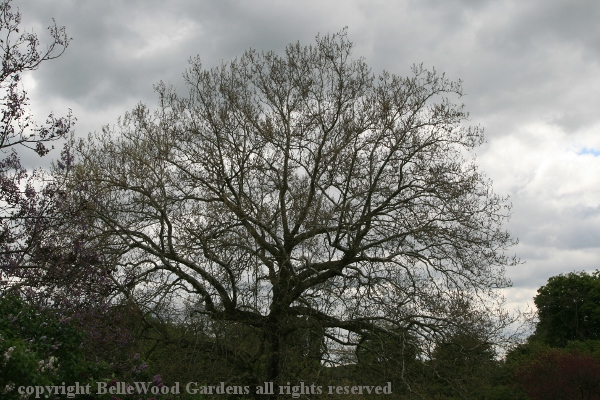
.
If you have any comments, observations, or questions about what you read here, remember you can always Contact Me
All content included on this site such as text, graphics and images is protected by U.S and international copyright law.
The compilation of all content on this site is the exclusive property of the site copyright holder.
The Architecture of Trees, a book review
Wednesday, 28 May 2019
The Architecture of Trees
by Cesare Leonardi and Franca Stagi

A tree stands alone. Its crown spreads, unimpeded by neighboring trees, or buildings, or pruning butchery to clear power lines. There is a consistency, from twig to branch to the overall form of the tree. Each kind is unique - the form of a red oak is different from white oak, and both are unlike a maple, or any other type of tree.
How then to choose a tree or several trees, for professional design of a park
or public garden, for your home garden, for a garden elsewhere in the world.?
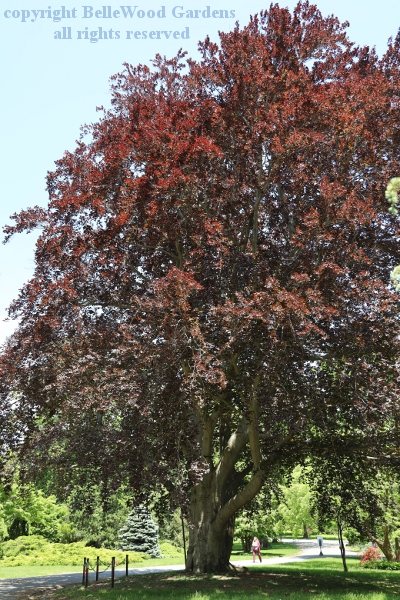
Look at a young tree in a pot and try to envision it a decade or two . . .
or a century on. This copper beech, one of several at Skylands Manor,
Passaic County, New Jersey, was planted in the 1920s. Hasn't it grown!
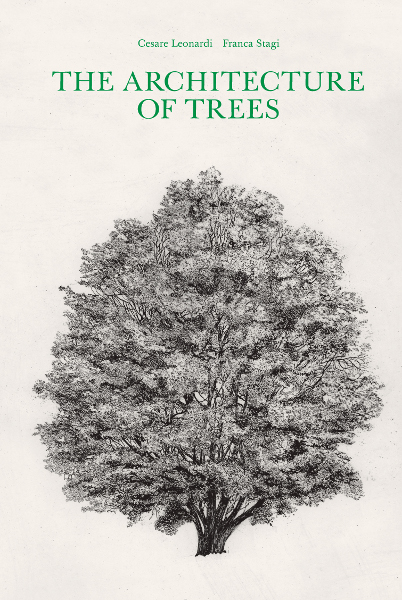
image courtesy of Princeton Architectural Press
This lavish, magnificently illustrated book offers a superb look at a world wide diversity of trees and some shrubs, 212 species in all. Through quill pen illustrations we are presented with both winter silhouette and summer leafy majesty.
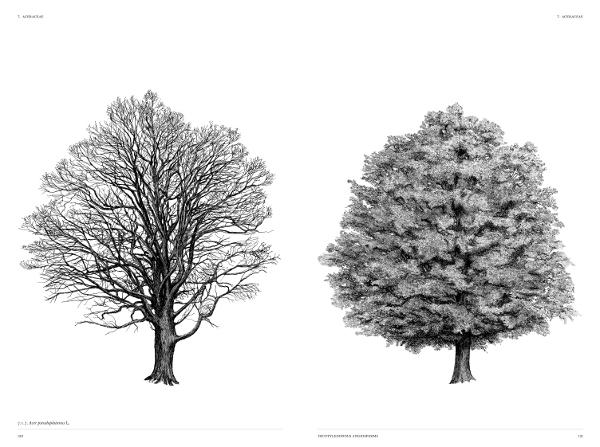
image courtesy of Princeton Architectural Press
Consider, for example, the pair of illustrations for sycamore maple, Acer pseudoplatanus. This native to northwest to central Europe, Italy, Western Asia is often used as a shade or street tree.
There are a majority of dicotyledonous angiosperms, (insect fertilized plants with two cotyledons or seed leaves), some monocotyledonous angiosperms (insect fertilized plants with a single seed leaf), and some gymnosperms (wind pollinated, naked seed plants.) Following the 550 exquisitely detailed drawings there is a section of text, a paragraph for each species of tree or shrub, that provided concise information about range, size, basic description, and a sentence or so more. This text is accompanied with detail drawings of a leaf or a spray of leaves, perhaps with flower or fruit.
Of interest to a botanist - or the botanically curious gardener - there is an alphabetical listing of plant families, paired with the page on which the genera begin to appear. The curious will be fascinated by the section that lists the era when each species was first grown in Europe, from pre-sixteenth century to nineteenth century. Examples: Common fig, Ficus carica, pre-16th century.Old field cedar, Juniperus virginiana, 17th century. Tulip poplar, Liriodendron tulipifera, 18th century. Osage orange, Maclura pomifera, 19th century.
Who would want this book? First published in 1982, L'Architettura degli Alberi, out of print for nearly two decades, was and is intended as an important addition for landscape architects, landscape designers, botanists, and anyone entranced by the diversity of trees.
Today, with digital images snapped on a whim with a cell phone, we have come to expect full color, enhanced images, instant gratification. Botanical art has options that digital does not. "The Architecture of Trees" shows us two different seasons. It enhances details, allows us to study and appreciate the form and structure of trees and shrubs.
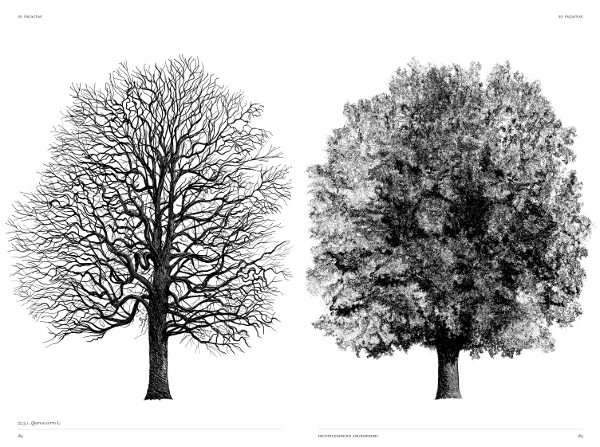
image courtesy of Princeton Architectural Press
I have both red and white oaks, Quercus alba and Q. rubra. as local natives. There are
others elsewhere in the world, such as Turkey oak, Quercus cerris, from southeastern
Europe and western Asia. Wind pollinated, its bitter acorns take 18 months to mature.
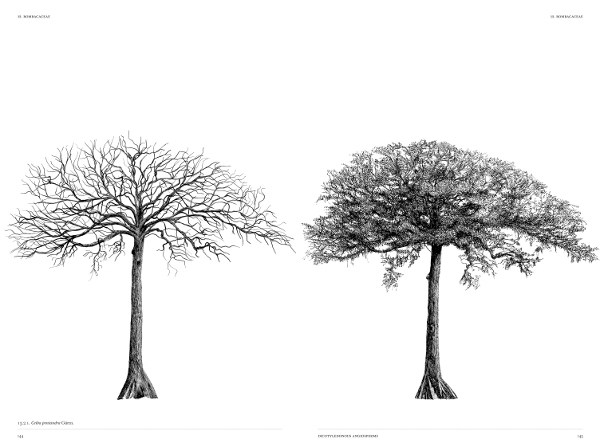
image courtesy of Princeton Architectural Press
Confirmed heights of 240 feet make Kapok, Ceiba pentandra, a towering giant
of the tropics: Mexico, Central America, the Caribbean, northern South America.
The butress roots that flare out at its base help stabilize the tree, which may have
a crown as much as 200 feet across, making it among the largest trees in the world.
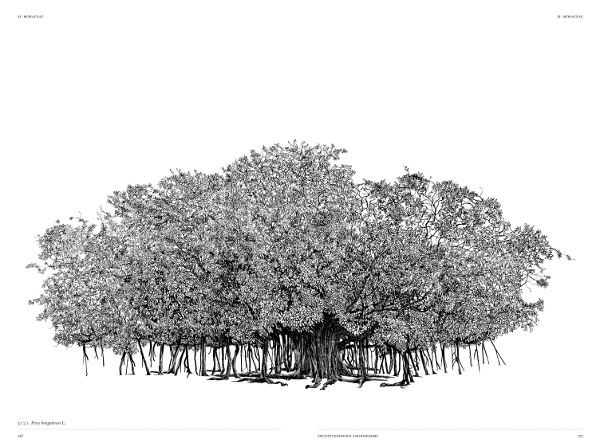
image courtesy of Princeton Architectural Press
Banyan fig, Ficus benghalensis is one I know not, even as a house plant. Native to the Indian Subcontinent, specimens there are among the largest trees in the world by canopy coverage.
There's a glossary of terms, from acaulescent / without a trunk, to walnut / indehiscent fruit that varies in size. Ever wonder how different genera got their names? Several pages for those mentioned or illustrated in this book will clarify this for you. For example, Cornus is from the Latin cornus (horn), which refers to the hardness of its wood. I remember learning that the wood of our native Flowering dogwood, Cornus florida, is so dense that it used to be used for flying shuttles in fabric mills, one of the few woods that would withstand the repeated slamming back and forth, back and forth, across the loom warp at 180 picks per minute.
Other interesting presentations: an essay by Franca Stagi on The City, Green Space, and the Architecture of Trees on the importance of green spaces, and the selection of trees in the architecture of parks.. An interesting and unique discussion of shade analysis with fascinating and elegant diagrams of shadow patterns. Latitude and longitude of Rome, Italy, for both a single tree and a separate set for a grouping of 45 trees in a grid-like array. Shadow pattern throughout the day, at the spring and autumn equinox, at summer and winter solstice. And for the grid arrangement, graphics for tree height of 5, 6, 7, up to 19 feet. Elegant! A thoughtful section on foliage color, with expanding and shrinking circles (mostly green, as might be expected) that brings home the changes throughout the seasons.
An excellent book with much to read, absorb, consider, and enjoy.
The Architecture of Trees by Cesare Leonardi and Franca Stagi
published by Princeton Architectural Press
202 Warren Street, Hudson, New York 12534
published March 26, 2019, hardcover, $125.00
10 x 15 inches, 424 pp, 550+ color & b+w images
ISBN 978-1-61689-806-9
A review copy of this book was provided by the publisher
Back to Top
Back to May 2019
Back to the main Diary Page